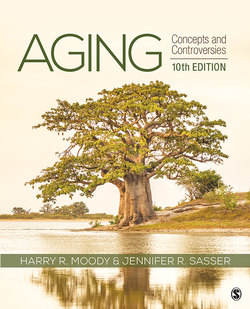Читать книгу Aging - Harry R. Moody - Страница 70
На сайте Литреса книга снята с продажи.
The Process of Biological Aging
ОглавлениеIn favorable conditions, a human being can live to around a hundred years old: A few live a bit longer than that, but not many and not for much more. Why is that? We don’t live to be a thousand years old, and, unlike some species, we don’t live only a few months. Why is that? Why a hundred years and not a few months or many centuries? This is a basic question about the process of biological aging.
Normal biophysical aging, also called senescence, can be defined as an underlying time-dependent biological process that, although not itself a disease, involves functional loss and susceptibility to disease and death. One way to measure susceptibility to death is to look at death rates. For contemporary humans, these rates double every 8 years. This pattern is known as Gompertz law (Kowald, 2002). In other words, a 38-year-old is about twice as likely to die as a 30-year-old, a 46-year-old is four times more likely to die than a 30-year-old, and so on. At any given age, there is an important gender difference: Although men and women age at the same rate, women at every age are less biologically fragile than men—contrary to what our cultural stereotypes might suggest. However, as we will discuss later in this book, there are disparities between women and men when it comes to patterns of chronic illness, disability, and active life expectancy.
Studies of different species of organisms show that aging is almost universal, but the causes of aging are complex. For instance, among animals whose body mass and metabolism are comparable, the rate of aging varies greatly (Olshansky & Carnes, 2002). Consider the differences in maximum life span among some familiar animal species shown in Exhibit 1.
The rate of aging can be correlated, in a general way, with the amount of time it takes for the mortality rate of a species to double. The doubling time is around 8 years for humans today, but only 10 days for a fruit fly and 3 months for a mouse. In rough terms, we can say that a mouse ages at around 25 times the rate of a human being.
What accounts for these clear differences in rates of aging and life span across species? Comparative anatomy—the study of the structure of different species—generates some insights into this question. For example, among mammals and other vertebrates, an increase in relative brain size is positively related to an increased life span. Other factors correlated with life span are lifetime metabolic activity, body size, body temperature, and the rate of energy use. For example, a tiny hummingbird has a rapid heartbeat and a high rate of energy metabolism; it also lives a comparatively short time, as if it were more quickly using up its total lifetime energy or action potential (Sacher, 1978).
Exhibit 1
Source: Data compiled from Walford (1983); Encyclopædia Britannica (2018); Did You Know? (2019).
Biologists have discovered intriguing relationships among life span, body size, relative brain size, and metabolic intensity. For example, a chipmunk has a maximum life span of 8 years, but an elephant can achieve 78 years. These facts suggest a more general idea known as the rate-of-living concept: roughly, the concept that metabolism and life expectancy are closely correlated. Smaller organisms, which tend to have a more rapid metabolism for each unit of body mass, also tend to have shorter life spans. A short-lived mouse and a long-lived elephant both have approximately the same temperature, but the mouse produces more heat per unit of mass. At the other extreme, slow-moving turtles are likely to have life spans longer than the more active mammals. Another fascinating fact is that no matter their total body mass, mammals have approximately the same number of heartbeats in a lifetime. Still, despite these tantalizing correlations, the rate-of-living theory has largely been rejected by biologists, along with the notion that biological aging is somehow necessary for the good of the species (Austad, 1997).
In comparison with other species of mammals, the human being has the longest life span and also expends more energy per body weight over the total life span than any other mammal. Energy metabolism per body weight across the life span in humans is about four times greater than that for most other species of mammals. Human beings have an average life expectancy and a maximum life span about twice as great as those of any other primate.
Compare the chimpanzee and the human being. The maximum human life span appears to be around 110 to 120 years; the chimpanzee’s is close to 40 years. But when we look at DNA from both species, we find that their DNA is more than 98% identical. These figures suggest that the rate of aging may be determined by a relatively limited part of the genetic mechanism. Calculations suggest that if a cell is determined by around 100,000 genes, then perhaps no more than a few hundred alterations in the genetic code are needed to change the rate of aging.
Scientists have posited that a large increase in maximum human life span occurred fairly recently—probably within the past 100,000 years. The speed of this development suggests that only a tiny portion of the human genome, representing less than 1% of the genetic code, was likely to be involved. If so few genetic mechanisms determine aging, then we can perhaps hope to intervene to delay the process of aging (Finch, 1990).
